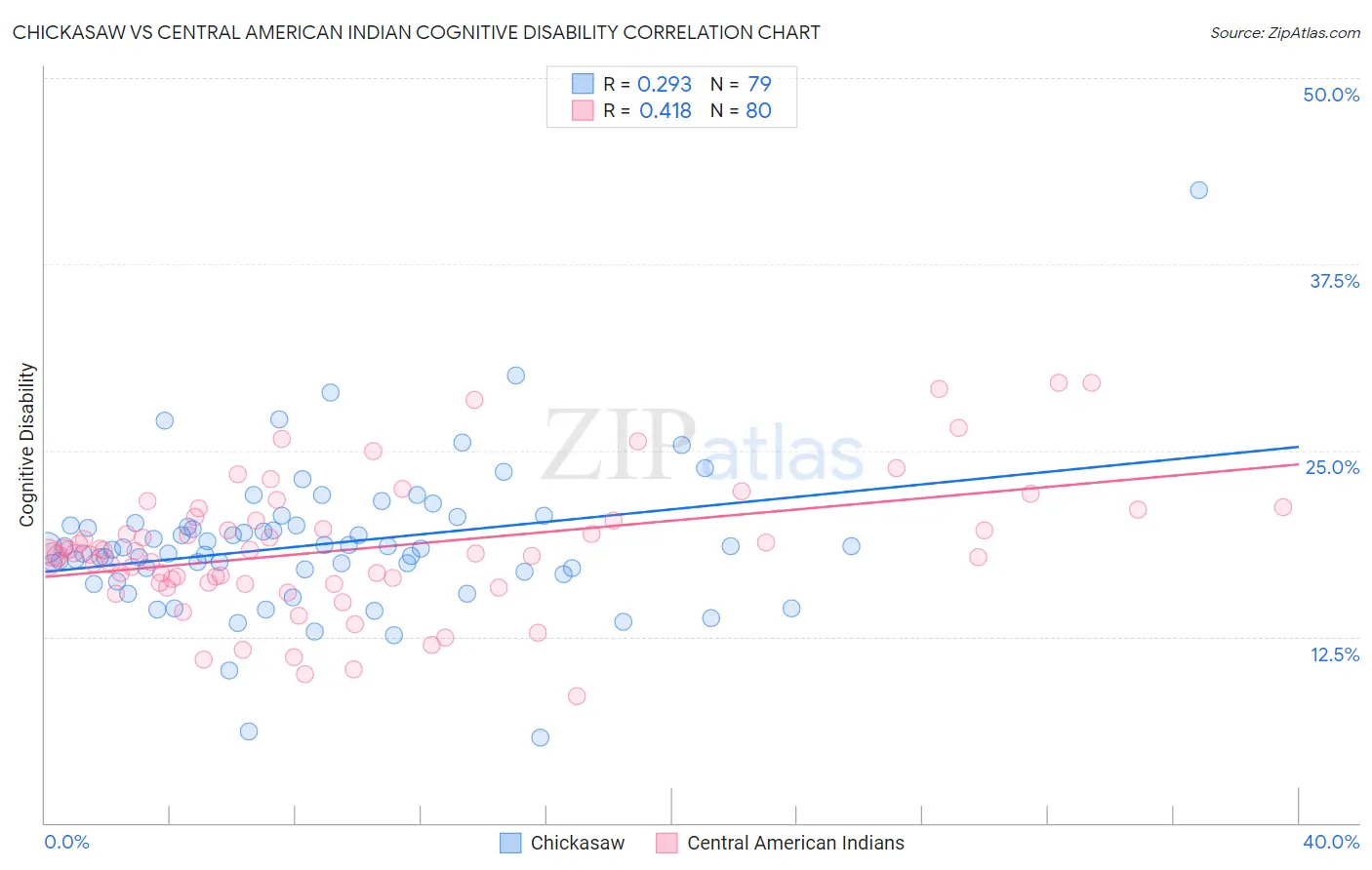Chickasaw vs Central American Indian Cognitive Disability
COMPARE
Chickasaw
Central American Indian
Cognitive Disability
Cognitive Disability Comparison
Chickasaw
Central American Indians
18.5%
COGNITIVE DISABILITY
0.0/ 100
METRIC RATING
312th/ 347
METRIC RANK
18.2%
COGNITIVE DISABILITY
0.1/ 100
METRIC RATING
293rd/ 347
METRIC RANK
Chickasaw vs Central American Indian Cognitive Disability Correlation Chart
The statistical analysis conducted on geographies consisting of 147,689,565 people shows a weak positive correlation between the proportion of Chickasaw and percentage of population with cognitive disability in the United States with a correlation coefficient (R) of 0.293 and weighted average of 18.5%. Similarly, the statistical analysis conducted on geographies consisting of 326,115,408 people shows a moderate positive correlation between the proportion of Central American Indians and percentage of population with cognitive disability in the United States with a correlation coefficient (R) of 0.418 and weighted average of 18.2%, a difference of 1.7%.

Cognitive Disability Correlation Summary
| Measurement | Chickasaw | Central American Indian |
| Minimum | 5.7% | 8.5% |
| Maximum | 42.5% | 29.6% |
| Range | 36.8% | 21.0% |
| Mean | 18.7% | 18.4% |
| Median | 18.5% | 18.1% |
| Interquartile 25% (IQ1) | 16.9% | 16.1% |
| Interquartile 75% (IQ3) | 20.0% | 20.4% |
| Interquartile Range (IQR) | 3.1% | 4.3% |
| Standard Deviation (Sample) | 4.9% | 4.4% |
| Standard Deviation (Population) | 4.9% | 4.4% |
Demographics Similar to Chickasaw and Central American Indians by Cognitive Disability
In terms of cognitive disability, the demographic groups most similar to Chickasaw are Hmong (18.4%, a difference of 0.29%), Choctaw (18.4%, a difference of 0.31%), Immigrants from Eastern Africa (18.4%, a difference of 0.68%), Immigrants from Western Africa (18.4%, a difference of 0.72%), and Seminole (18.3%, a difference of 0.81%). Similarly, the demographic groups most similar to Central American Indians are Iroquois (18.2%, a difference of 0.010%), British West Indian (18.2%, a difference of 0.070%), German Russian (18.2%, a difference of 0.24%), Immigrants from Burma/Myanmar (18.2%, a difference of 0.27%), and Blackfeet (18.3%, a difference of 0.41%).
| Demographics | Rating | Rank | Cognitive Disability |
| Iroquois | 0.1 /100 | #292 | Tragic 18.2% |
| Central American Indians | 0.1 /100 | #293 | Tragic 18.2% |
| British West Indians | 0.1 /100 | #294 | Tragic 18.2% |
| German Russians | 0.0 /100 | #295 | Tragic 18.2% |
| Immigrants | Burma/Myanmar | 0.0 /100 | #296 | Tragic 18.2% |
| Blackfeet | 0.0 /100 | #297 | Tragic 18.3% |
| Japanese | 0.0 /100 | #298 | Tragic 18.3% |
| Ghanaians | 0.0 /100 | #299 | Tragic 18.3% |
| Creek | 0.0 /100 | #300 | Tragic 18.3% |
| Immigrants | Ghana | 0.0 /100 | #301 | Tragic 18.3% |
| Barbadians | 0.0 /100 | #302 | Tragic 18.3% |
| Immigrants | Kenya | 0.0 /100 | #303 | Tragic 18.3% |
| Immigrants | Eritrea | 0.0 /100 | #304 | Tragic 18.3% |
| Colville | 0.0 /100 | #305 | Tragic 18.3% |
| Seminole | 0.0 /100 | #306 | Tragic 18.3% |
| Ugandans | 0.0 /100 | #307 | Tragic 18.3% |
| Immigrants | Western Africa | 0.0 /100 | #308 | Tragic 18.4% |
| Immigrants | Eastern Africa | 0.0 /100 | #309 | Tragic 18.4% |
| Choctaw | 0.0 /100 | #310 | Tragic 18.4% |
| Hmong | 0.0 /100 | #311 | Tragic 18.4% |
| Chickasaw | 0.0 /100 | #312 | Tragic 18.5% |